
Project
Circular Management of Urban Organic Residues to Restore Ecosystem Services of Agricultural Soil (CURESOIL)
The continuous decrease of soil organic carbon (SOC) results in the soil quality degradation and poses an increasing challenge with respect to food production and environmental protection. Meanwhile, the amount of urban organic residues (UOR) is steadily increasing with the growing world population and urbanization. Matching the SOC demand with the OC from UOR may be a win-win solution for both the soil ecosystem services restoration and the UOR circular management.
It is hypothesized that the nature of urban organic residues determines the way of OC recovery and the most appropriate scale for recovery and reuse.
Practical Challenge
The variety of urban organic residue streams used as input, technologies applied and nutrients (mainly N,P,K) produced make a difficult comparative assessment for the applicability of the products and their effect on the SOC content and the different ecosystem services that agricultural soil could provide.
Objective
To maximize the effectiveness and impact of using urban organic residues for replenishing soil organic carbon to restore multiple ecosystem services provided by agricultural soil.
Approach
- Assess the current status of OC required by agricultural soil and supplied by urban organic residues;
- Investigate obstacles that hinder the carbon recycling. Three aspects are included:
o The quality of urban organic residues;
o The rationality of processing strategies;
o The suitability of applying treated products to particular soil. - Simulate strategies to match the actual SOC demand with the OC supply. Build a decisionmaking model;
- Evaluate the proposed strategies and complete
the model with judgmental indicators.